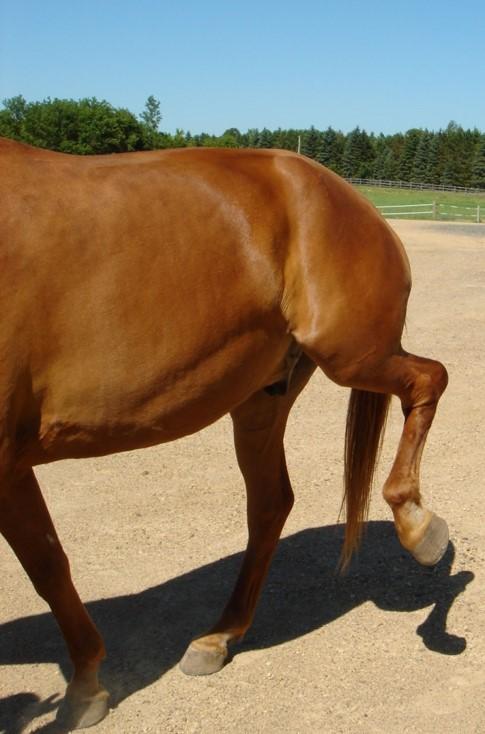
Shivers
What is shivers?
Takeaways
- Shivers is a neurologic disease characterized by an abnormal gait when backing up.
- Clinical signs often begin at a young age and progress in severity.
- Male horses that are 16.3 hands in height and taller are at higher risk for shivers than other horses.
- There is no specific treatment for shivers, but affected horses appear to have fewer episodes when kept in consistent work and time in a stall is minimized.
Shivers is a progressive neurologic disease classically characterized by an abnormal gait when backing up. It is caused by damage to specialized nerve cells (Purkinje cells) of a specific area of the cerebellum, but the underlying mechanism is unknown.
Clinical signs of shivers usually begin before five years of age and progress in severity. Both males and females can be affected, but geldings are more likely to be diagnosed with the disease. Taller horses (over 16.3 hands) are also more likely to be affected than shorter horses. Shivers has been reported in several breeds, including draft horses, warmbloods, Quarter Horses, and Thoroughbreds.
What are the clinical signs of shivers?
Clinical signs of shivers may be difficult to detect in the early stages of the disease. Affected horses typically exhibit hyperflexion (hindlimb is held up and away from the body and often trembles) or hyperextension (feet are placed further back than normal) of the hind limbs when backing up. Most horses are affected in both hind limbs. It is rare to observe clinical signs of shivers in the forelimbs. In some cases, muscles in the face and neck are affected, and may contract spasmodically.
In severe cases, clinical signs may be observed when the horse is moving forward, but often only in the first few steps (especially after standing for a period of time) or when making a sharp turn. Clinical signs are not present at the trot.
Affected horses may be resistant to having their hind feet picked up for cleaning or farrier work. Stress and excitement can cause episodes of shivers.
Muscle atrophy, especially of the thigh muscles, occurs as the disease progresses. This often leads to hindquarter weakness.


How is shivers diagnosed?
There is no specific diagnostic test for shivers. A diagnosis of shivers is based on clinical signs and ruling out other potential causes, such as stringhalt, equine protozoal myeloencephalitis (EPM), and others through lameness and neurological examinations along with other diagnostic testing. It is important to recognize that many horses may demonstrate hyperflexion when asked to pick up their hind feet, but they back up normally. These horses do not have shivers but instead likely have an underlying orthopedic issue. A diagnosis of shivers requires the horse to demonstrate clinical signs while backing up.
How is shivers treated?
There is currently no treatment for shivers. A consistent fitness program, access to turnout, and limited time in a stall are suggested for affected horses since movement has been reported to minimize clinical signs. Learning and limiting each horse’s specific trigger(s) is also important, along with reducing stress and excitement that may trigger episodes. Your veterinarian may recommend supplementing your horse’s diet with vitamin E and selenium.
What is the prognosis for shivers?
Many horses, especially those that are mildly affected, are able to train and perform at high levels. Horses that are more severely affected and/or showed clinical signs of shivers at an early age may experience decreased performance over time. It can become increasingly challenging to perform farrier work on affected horses, which may have implications for hoof health and soundness. Sedation with xylazine or detomidine can provide some relief during shoeing.
How can shivers be prevented?
A genetic predisposition for shivers has been suggested based on prevalence of the disease in certain breeds, but no specific cause has been identified. Research suggests that the antioxidant vitamin E, which has important roles in healthy nerve and muscle tissue, may be especially critical in horses at risk for shivers.
For more information
Draper, A.C.E., Trumble, T.N., Firshman, A.M., Baird, J.D., Reed, S., Mayhew, I.G., MacKay, R., Valberg, S.J. 2015. Posture and movement characteristics of forward and backward walking in horses with shivering and acquired bilateral stringhalt. Equine Vet J. 47(2): 175-81.
Draper, A.C.E., Bender, J.B., Firshman, A.M., Baird, J.D., Reed, S., Mayhew, I.G., Valberg, S.J. 2015. Epidemiology of shivering (shivers) in horses. Equine Vet J. 47(2): 182-7.
Valberg, S.J., Lewis, S.S., Shivers, J.L., Barnes, N.E., Konczak, J., Draper, A.C.E., Armién, A.G. 2015. The Equine Movement Disorder “Shivers” Is Associated With Selective Cerebellar Purkinje Cell Axonal Degeneration. Vet Pathol 52(6): 1087-98.
*This article may not be reproduced without the written consent of the UC Davis Center for Equine Health. Please email requests to cehadmin@ucdavis.edu.
